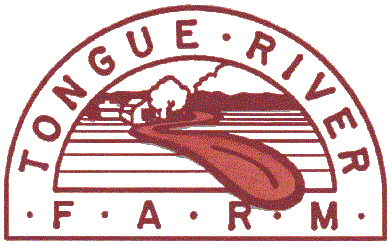
Home | Breeding Stock | Products | Contact Us

Home | Breeding
Stock | Products
| Contact Us
Tongue River Farm
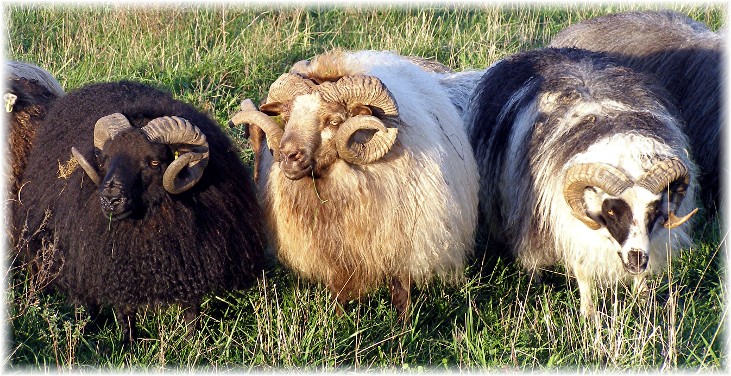
SRX744S-AI Saga by Rector--SRX413P Patriarch (Bambi/Horvi)---SRX867S Superman (Lomji/Horvi/Bambi/Blaevar/Hunn)
November 25th 2007
It was the Saturday after Thanksgiving and a group of wonderful friends and neighbors gathered at the farm to help in the process of Artificial Insemination of some of the sheep. LAI is a surgical process where the semen is put directly into the uterus through the abdomen. 32 ewes were successfully AIed to 14 different rams which included Sveppur, Ormur,Topper, Snoddi, Hnokki, Mori, Partur, Mango, Abel, Rector, Vidir, Nali and Aboti. I select rams that have excellent fleeces, prolific daughters, high milking and prolific mothers.
Color is important but the white rams seem to be consistently better in most cases. So I breed the white Iceland sires to my best young colored ewes in hopes of bringing out the color in the next generation. Yes, I could just breed for color but when I have done this before I have been disappointed with the quality of the lambs overall. The lambs are of a higher quality when I breed the white Iceland ram genetics into my colored ewe flock with high percentages of AI genetics. I get a lot of white offspring this way but the quality is spectacular.
The offspring will widen the genetics of the flock. With chaotic global politics and threat of disease outbreaks we never know when the importation of semen from Iceland may be prohibited, maybe forever. So each year we make an importation of semen collected from the best genetics that Iceland has. We are lucky to be able to get this valuable genetic source. We now wait to see how many ewes conceived. The lambs are always spectacular. Spring will bring nice surprises.
Now I will be busy getting the rest of the flock put into breeding groups with the AI home raised rams. There are about 17 that will be used this year. I will have some bred ewes available in January.
There is plenty to do in the
winter besides taking care of the sheep in their breeding groups. My yarns have
been well accepted by the knitters and they enthusiastically almost bought me
out at Rhinebeck this year. The sheep and I are busy getting more fleece to the
mill for processing. To see more lace shawls made of our yarn see the lace yarn
and sock yarn pages. This is just a sample.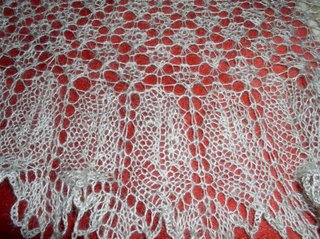 It changes your outlook when you see the sheep out in the field wearing
beautiful fleeces. I now picture them wearing future works of the knitters art.
It changes your outlook when you see the sheep out in the field wearing
beautiful fleeces. I now picture them wearing future works of the knitters art.
888888888888888888888888888888888888888888888888
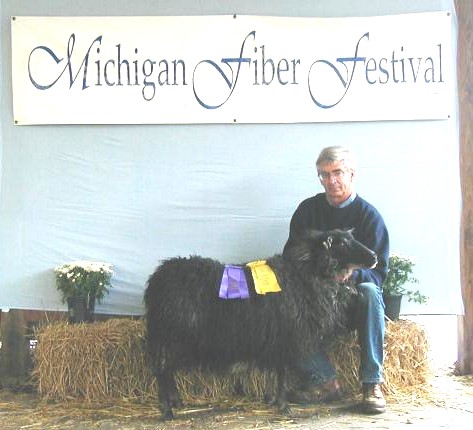
Summer 2007 Alan Leighton does it again! His yearling ewe TCE301S won Grand Champion Icelandic Ewe and then went on to be the Supreme Champion Ewe over all breeds. This is the second year Alan's ewe has taken these honors. Congratulations to Alan and his ewe. TCE301S is a polled black mouflon. TCE301S is sired by SRX109N (Flekkur/3D/45D/Hnykill) and bred by Tongue River Farm. This is the second year in a row that Alan has won top honors with ewes sired by Tongue River farm rams!
Spring Newsletter 2007
The shepherd builds a "Shepherd's" house
I moved to the new farm in Pomona MO in June of 2006. I was lambing while I was moving (not recommended). The old house that was there looked in poor shape but I figured on putting on a new roof, some new ceiling and a few repairs and move in. I knew that somewhere down the line I would have to build a new house as the old farm house had seen better days. I wasn't prepared for what turned out to be a house that was self destructing. Everything in the house needed to be fixed or replaced. The sills were rotted, the elect and plumbing didn't work. The windows fell apart when you opened them. The roof leaked when it rained and there were big holes in the floor. The place was infested with mice and rats. Ugh. I patched the roof with tar, tore out the rugs, tore out the ceilings and put up new drywall ceilings and plugged the rat holes. This made the place useable for storing my household stuff and yarn business. I set up a little office inside. But I lived in my daughters travel trailer. This arrangement was great until winter set in.... Meanwhile I set about finding house plans that would be good for a shepherd. What I found was that most house plans are designed for those that live close to others and are focused inwardly... minimal windows and the kitchens in the middle of the house and little natural light. My house sight was on side of a hill overlooking a valley that was my farm. From this vantage I could see 3/4 of the pastures and sheep. I couldn't find what I wanted in a house plan so I decided to design my own. My father had built 2 houses of his own design, simple and functional. I figured that I could do the same. I made a rectangle with the long side running along the side of the hill. I divided the inside into 6 even squares with an entrance hall between 2 of them. The roof would be low and metal. I would be using wood as my heat source and metal would be safe and long lasting. I made one room a wool room, one a combo utility and bath and mud room. The kitchen, dining and living room became one big great room with a wood stove as the focal point. A big office was essential for my sheep business as I spend 1/2 of my time doing office work. But the best feature of the house is the banks of windows. Most of every outside wall is huge sliding windows that take in the fabulous views in all directions. it also lets in great amounts of natural light. You don't need to turn on a light in the day time. There is a big commercial stainless sink in the kitchen and a big kitchen sink in the bathroom for washing wool etc. I started construction in August with the pouring of the foundations.
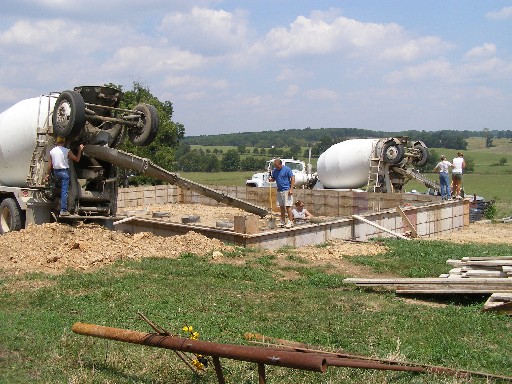
I had to wait till late September to get the contractor as he was busy with other projects. The floors sub floors were done and the outside framing was done before I left for Rhinebeck
Jerry looked at my plans and started to work on the beam and sills.
Funny how small a house looks when you start it and how it grows in size as you close it in.
In March I was able to move in even tho the house was not totally finished. This summer my family helped me paint most of the inside and outside. I am still moving in gradually and playing catch-up with my business, the sheep and everything else.
The flock has had minimum care this spring and summer. We are looking forward to cooler temps of Fall to make more progress on the infrastructure.
I have just one field to finish the sheep fencing on in order to make more pastures to use for rotation. I hope to be able to lime some of the fields and put in more water lines to more didtant fields by next year. Many of my fields have ponds but they dry up in summer and are sources of parasite contamination for the sheep.
I would also like to get the fields limed in 2008. They have been neglected for years and I would have done this right away if it had not been for starting to build the shepherd house.
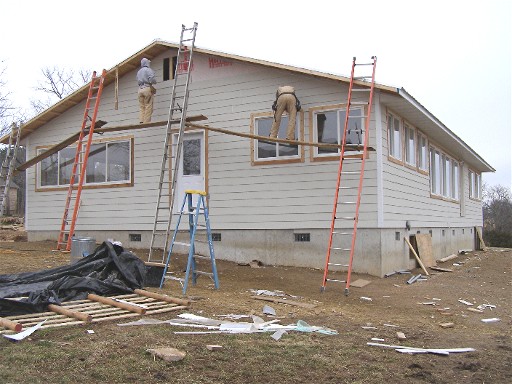
finishing touches on the new shepherd's house
----------------------------------------------------------------------------------------------------------------------------------
Spring Summer Newsletter 2006
Tongue River Farm is on the move AGAIN!!! As this is being
written the living room is filled with boxes and “stuff” ready to take to
the new farm that we have nicknamed “Wisteria” for the wild rampant vines
that are taking over the old milk barn on the Farm in
Why did I decide to move? More pasture (120 acres), better land (1/3 bottomland and the rest nice pasture), crossed fenced for rotational grazing, water in each pasture (pipelines and 5 ponds), lots of usable barns and outbuildings, closer to family and like minded community, closer to town (10 miles), pastures mostly visible from the house for better predator protection. These are some of the reasons for the move. The farm is an old dairy that has been sorely neglected for years, especially the house which is not livable. I fell in love with the land which is a gentle valley with a dry creek running through that hardly ever runs. If I were to find this kind of quality land with a great house on it the price would be twice as much. Besides I love to bring neglected farms back to life. I will be camping in a travel trailer till a new house is built. Coop sweet coop! This will give me extra incentive to get busy and get the new house built. J
haying the new farm
My health is better and I plan to expand the flock again to
150 to 200 ewes. The
SRX363P "Pandora" won grand Champion ewe at the National Icelandic show in Rhinebeck New York in Oct 2005!

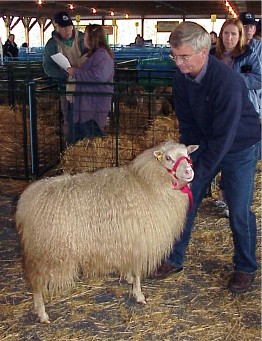
Thanks to Alan Leighton for showing her. "Pandora" not only won her class and then the Championship but had the highest score (83.5) of any of the sheep in the show. Her bloodlines include AI rams Dalur, Sveppur and Dropi. Her sire is Navaho SRX26N and dam SRX786L. Her twin sister is every bit as beautiful.
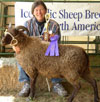 Grand Champion Ewe Estes Park in 2002
Grand Champion Ewe Estes Park in 2002
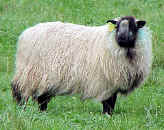 National Grand Champion Ewe 2001
National Grand Champion Ewe 2001
fencers at work
Nine trips will be made to take the whole flock and many more to haul all of the sheep equipment and all of my stuff. Luckily it is only 100 miles away. Moving brings home to me how much “stuff” I accumulate over the years and how much of it is not essential and has not been used in years and ought to be liquidated or passed on to others that can use it.
new chute and mailbox
The third project will be to learn more about animal health and nutrition on Southern pastures. This is a challenge as entophyte infected fescue grasses dominate and thrive in Southern pastures. The entophyte causes many animal health problems. Diluting the grasses with other grazing options is one solution, clovers, chicory, orchard grasses, lespedsa, perennial rye, crabgrass and bromes are options that I will try. The farm also needs liming, a good cleaning and pick-up, dumpsites cleaned and brush hogged. Plans include planting northern hardy pecans for nuts and chestnuts. The old tall classic red barn that is there is a dinosaur as it is impossible to find help to put up and stack small square bales in its 2 story loft anymore so it will be eventually replaced.
AI results.
We were lucky to have 23 lambs born this spring from
imported semen from
Lambs by Nali
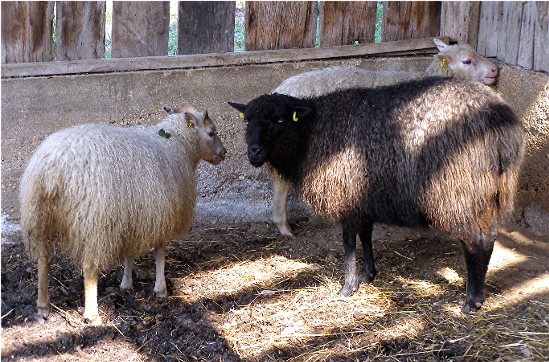

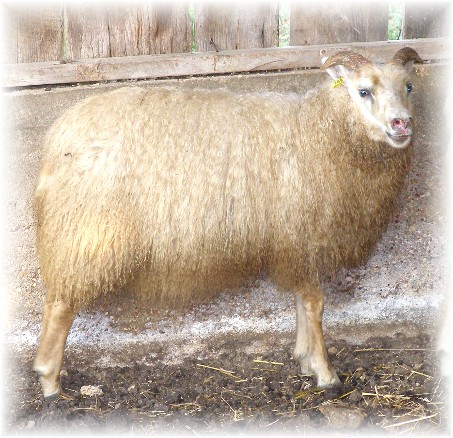
Lambs by Dalur

Lambing results/Wild
sheep!!!
Often the lambs would be several days old when I would first see them as the dam had them in the woods and stayed hidden till they were well bonded and would follow Mom well. The flock was semi wild, ranging widely and hiding their lambing spots well. The deep woods everywhere on the old farm made this possible. The ewes are well aware of predators and very defensive of their lambs and few were lost in spite of the ewes staying out in the wild areas day and night. Now this is not how I want things to be. I would prefer to have more control of the flock. But under the circumstances the flock did fabulously and the hard culling paid off in easy lambing and excellent mothers that are milking well. The lime that I put on last year has had an astounding effect of the pastures. There are about 129 lambs running around and it is truly a glorious sight.
Pandora (National Grand Champion Ewe has white twins (both carrying moorit), one ram, one ewe, sired by SRX283P who won his class at Rhinebeck against tough competition with a score of 80.5. Pandora’s udder is fabulous in shape size and teat placement. The lambs look great! (Future show winners?)
Summer sales lists.
We have a nice selection of ewes with lambs at side as well
as ewes for sale. The list includes a Hnykill AI daughter that tripleted this
year with her ram and ewe lambs. The ewes with lambs at side price is only good
for a short time and only for pick up immediately. As soon as the lambs are
weaned the ewes and lambs will be re-evaluated and repriced. This
is your chance to purchase a package at the lowest price (ewe and her lambs).
The lambs list will be out as soon as the lambs are evaluated at 12 weeks of age.
Fleeces, Yarn and
Roving:
on interest to the country that raises the most Icelandic sheep in the world.
We also introduced new alpaca, merino, Romney, mohair, silk and Icelandic blend roving this last fall and it has been a success. The fibers used in our blends were award winning fleeces so is of the highest quality. Taos Wool Mill processes the finest easy to spin roving I have ever used. Rhinebeck customers tell us that it is easier to spin and more beautiful that all of the other roving from other vendors at Rhinebeck. We have 4 colors and 4 blends for spinners to try. It was a hit at Rhinebeck this last fall.
If you are coming up with felted fleeces at shearing time in the fall, don’t despair. One enterprising felter Maggie Romage of West Virginia takes these felted fleeces and creates fabulous patchwork felted rugs with them. the photos are a sample of her work
Also in her new book called New Felt by Birgitte Krag Hanson has several pieces made with felted fleeces. She considers a felted fleece to be a treasure. Here is a market for those occasional felted fleeces!! She felts faces and designs right into the raw felted fleece. Very beautiful.
Building your sheep
business/ We can help:
at least pay for itself. Others dream of getting out of the
rat race and building their Icelandic sheep business into a full time job that
will replace the income that their
New marketing ideas:
common folks, learn how to do the same. In the process Doug and David have fun, recharge and get ideas that help them too. Their program is lively, informative and fun. I am enjoying their book and CD and it is crammed with ideas for marketing etc. Listen to their radio programs at www.doughall.com
You need to invest in an ongoing education programs, books classes of some sort to keep the flow if ideas going. The Stockman Grass Farmer is one of the best publications to do this. http://stockmangrassfarmer.net/ Get some of their tapes from the ISBONA library. Order others direct or from your library interlibrary loan or buy them from the magazine. The SGF is on the cutting edge of how to make money with livestock. It is for big farms and little ones alike. The Allen’s Obs column is worth the price of the magazine alone.
Many persons have a wrong idea of what constitutes true happiness. It is not attained through self gratification but through fidelity to a worthy purpose….. Helen Keller
New articles on
Icelandic sheep, shepherds and marketing:
If you have wanted to try pasture lambing read the new
article on the subject. Pasture lambing.
Grey Pet is one
of the original ewes imported from
Marketing on the Internet highlights some food for thought for marketing your sheep and sheep products via the World Wide Web.
Jim Londagin was the Icelandic dairy sheep expert in
Moving showing or selling sheep this year? You will want to bookmark the USDA site for import rules. http://www.aphis.usda.gov/vs/sregs/ Be sure to call the state where the sheep will be going for any changes in the rules. Many times the website is not kept current. It is the responsibility of your vet make sure that your sheep are compliant with the rules of the state that is the sheep’s destination. Be sure to allow plenty of time for the testing to be done. As it can easily take several weeks to get the results back. Rams, especially, are usually tested for B Ovis and sometimes Bluetongue. If your sheep test positive for Blue Tongue you can test further to see if they are infective or just have a titer for the virus. If the sheep aren’t infective they will be allowed to travel.
“Try” finds a way
Tips: Use a felting needle to join the ends of yarn that comes apart or
when joining ends for a seamless join. Use the felting needle to mend socks with
a piece of wool or yarn. Easy and fast.
Wormers to add to your management list.
Use Basic H at the rate of 1 cup per 100 gallons of water. Don’t allow the sheep to have any other water source for 2 days. Repeat this 6 times a year.
Add bentonite clay to your mineral mix. The sheep will readily eat it and it is a natural wormer that animals use to treat themselves. Bentonite is used to help stick pelleted feed together.
Add Safeguard to the mineral mix for a few days till you are sure that all animals have had a change to access it. It can be bought in a loose salt mineral mix for cattle from places like Jeffers.
If barberpole worms are a problem try Cydectin cattle pour-on and administer it by mouth at the rate of 1cc per 25 lbs. Have on hand plenty of syringes to use as this liquid jams up the rubber rings on the syringe after a few uses.
Do all that you can
With what you have
In the time that you have
In the place where you are.
….Teddy
Nordic
sheep breeds: www.rala.is/beta/ Blood samples were taken to determine DNA markers. Histories and
information on the breeds and results of the research with nice photos.
If you
have a guard dog pup that is chasing your sheep you can put a stop to it by
muzzling him till he learns not to do this bad behavior. The muzzles are removed
once a day so that the dog can eat. Custom made muzzles www.morrco.com/morwirbasdog
Want to
try sheep milk yogurt? You can mail order from www.blacksheepcheese.com Yum!!
Spring has rushed in and has brought with her approximately 300 lambs frolicking all around the fields. With the garden to plant, the fields to irrigate and the start of haying season we are keeping busy. We are lucky to have irrigation water when much of Montana farmers are in a severe drought and have no water to use to use. Cattle are being sold or trucked to pastures in other states. Our watershed has had 70% snow pack and a newly repaired dam and hopefully we will have enough water to irrigate the pastures. Projects planned for this year on the farm include fencing in one of the river peninsula pastures of about 20 acres that is bordered by the Tongue River and Cowles Creek. It is a difficult fencing project with many brace posts needed to follow the many curves and dips. We also have to consider the annual flooding and spring ice breakup when determining where the fence will be put. Ice cakes the size of small houses play bumper derby in the swollen, over-the-banks river each spring. Fencing that is too close to the river cannot withstand this onslaught so we have charted the low areas and will strive to fence on the high ground.
So with the help of my friend Rona we are taking on this project. We need to have this pasture ready for sheep before the really hot weather sets in. Most of our pastures have little or no shade as Rex thinks that it is a forbidden act to plant trees in a hay field. The river pasture that we are fencing has lots of big shade trees and cool river breezes. We will utilize this new shade pasture by grazing the treeless hayfields at night and the river shady pastures during the heat of the day. The sheep learn the routine easily and move themselves if the gate and lane is left open.
Rona is a hard task master and super fence builder and scolds me if I don’t tamp the corner posts enough. With her help this should be a 40-year fence! She and some other friends and neighbors, Charlie, Tucker, Glenna helped tear out old cattle chutes and repair the barn and corrals, replacing roofing, rehanging gates, building stalls, putting in dividing fencing and setting up the sheep handling equipment in time for the start of AI lambing. Thanks to them lambing went well. We have not previously used this barn and corral, as it is one mile from the house at the site of the original 1800’s house, now long gone. But the flock has grown big enough so that we now need this bigger neglected facility. We used the tractor to pull up the poorly designed cattle chutes and put in sheep friendly working pens. Rona accused me of having too much fun, plucking out the old posts. A tractor with a front-end loader is a wonderful tool!!!
Artificial
Insemination (AI)
Last Fall we AI’ed 33 ewes with
semen of 8 new rams that we had imported from Iceland. Martin Daily, our AI tech
did a great job and we ended up with an 88% success rate with 29 ewes producing
63 live lambs for a 217% result. Some of the recipient ewes are AI offspring
from our 1999 lamb crop so their lambs are ¾ imported genetics and are
spectacular.
We were delighted when some of the
offspring of Hnykill turned out to have a rare pattern. We hope that it is the
Grey/Mouflon-Single-Gene pattern.
All the AI lambs are spectacular and take your breath away with their
beauty.






The main flock followed on the heels of the AI ewes and resulted in 232 live lambs. Lambing went well and assistance was rarely needed. We ended up with 5 bum lambs that are being raised by our neighbors at the Oh Too Cute Farm
I slept each night during lambing. With pasture lambing the ewes do the work and you are the support crew making sure there is pasture, water, mineral, tag the lambs, and record the births. We have selected for easy birthing and it is really paying off.
It is always a hard decision at breeding time whether to breed for color or herd improvement. You of course can do both at the same time sometimes but when you have the choice of using spectacular white AI rams or nice (but not spectacular) colored/patterned rams, what would you do? The biggest market in the USA is for colored/patterned sheep. White is very dominating and 75% of their lambs will be white when bred to colored ewes. I was faced again with this decision this fall: white for fast flock improvement or colored/patterned for higher sales? I decided that I wouldn’t be happy with anything but the best lambs that I could produce even if they were all white. Every year I have 16 breeding pens and 50 great rams to choose from. I suffer from too many good rams. Most of these good rams are white and too good to butcher. The genetics is precious, hard won, and expensive to procure. We think that these fabulous rams will improve the Icelandic sheep in North America but no one wants to buy white rams. So Tongue River Farm will be giving selected white AI rams away for Free with an $800 purchase from our sales list. Only one to a farm/person, please, as we want to spread the genetics as much as possible. This offer is good only as long as supplies last. Take advantage of this opportunity to improve your flock with the best genetics from Iceland. If we deliver the sheep ourselves then shipping for the free rams would be free. If we have a shipper deliver the rams then the buyer will pay the shipper. It cost about $100 for each animal last year but might be a bit more if gas prices stay up this fall.
You must be enrolled in the
Voluntary Scrapie Eradication Program in order to receive the AI rams. We do
have a few white rams that are ½ AI genetics that can go to a farm that is not
enrolled in the VSP. Ask us for details!
We were delighted one morning to discover a yearling ewe with triplets, all dry and fed. In looking at the pedigree of this ewe we noted that both her sire and the ram that she was bred to were Hunn offspring (the AI sire that is carrying the Thoka gene, multiple births). We have never had a yearling give birth to triplets so we are assuming that this ewes carries the Thoka gene. Her full sister was also prolific having a set of twins. This is exciting news as we can now breed more prolificacy into our flocks. Iceland is not too interested in this multiple birth gene as they have a very short growing season and have limited forage to grow out smaller lambs to market size. However we have plenty of forage and a long enough growing season to grow out multiple lambs. We are delighted with these exciting genetics. Multiple birth ewes produce higher profits. Two of these productive triplet rams will be for sale.
Dairy
Sheep
History:
Icelandic Sheep have been used for the main dairy animal in Iceland and known as the poor mans cow for 1000 years. Not until the 1940’s did this change with the advent of mechanized haying in Iceland, which allowed enough hay to be harvested to use cows as the primary dairy animal. Up until that point in time all haying was done by hand. Haying season was very short and frequent rain was always a problem. Only rich farmers could afford to put up enough hay with hired labor to keep a cow. So the Icelandic sheep was the main dairy animal for most farms. The sheep were expected to winter over on the equivalent of 2 square hay bales of hay, the fat on their backs and winter grazing when conditions were suitable
Lambing took place in May and June and was timed for warmer weather and the emergence of grass. Sometimes a ewe was milked out before she lambed and this watery fluid was used to make glue that was used in bookbinding, woodworking and made into glazes and ink. The first milk or colostrum was usually left for the lambs. If an excellent milker had more than her lamb needed then the colostrum was made into custard.
The shepherd started to wean the lambs two weeks after they were born, by corralling the ewes in the evening about 6PM. The lambs were then separated from the ewes for the night with the ewes being released to graze all night under the care of the shepherd. In the morning at 6AM the ewes were corralled and milked out. After milking, the lambs and ewes were reunited to spend the day together.
This process went on for 4 to 6 weeks until the lambs were mature enough to be fully weaned. At this time the male lambs were castrated and driven up into the mountains or to inland common pastures along with the horses and other non-milking stock. The cows and ewes that were being milked were kept behind. The ewes were then milked 2 to 3 times a day and most gave a liter. Good milkers gave 2 or even 3 liters. The milk was used to make butter, cheese or skyr, which is a semi-soft cheese similar to thick yogurt mixed with cream cheese.
Today there is growing interest in establishing small farmer owned sheep dairies. The lucrative sheep cheese market in the USA has fueled interest in these specialty farm enterprises. Sheep milk is high in fat and dissolved solids which are what is need to make excellent, high yielding cheese from relatively small amounts of milk.
Sheep milk is also being made into very profitable yogurt, which is velvety smooth, creamy and naturally sweet. It needs no sweetener or fruit to make it palatable. It is a desert quality dairy product.

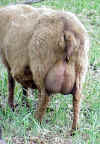
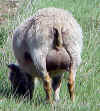

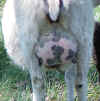 The problem is to find excellent milking stock that is both hardy and has
an excellent yield of milk for 180 days. Until now the leading milking sheep
breed was the East Friesian, which has been selected for high milk production.
Unfortunately the breed is not hardy and the lambs are frail and have a low
survival rate. The East Friesians also need inputs of grain in order to produce
high milk yields. Since grain is the biggest cost in livestock production,
animals that need grain, lower profits. Icelandic sheep on the other hand are a
hardy grass based breed that produces high yields of milk on grass alone.
Animals that can thrive on forage alone bring higher profits to their shepherd.
Icelandic sheep are reliable twinners and have vigorous lambs that thrive. In
addition their fleeces bring top dollar as specialty wool. Their meat is known
worlds wide as the best lamb for flavor, texture and tenderness.
The problem is to find excellent milking stock that is both hardy and has
an excellent yield of milk for 180 days. Until now the leading milking sheep
breed was the East Friesian, which has been selected for high milk production.
Unfortunately the breed is not hardy and the lambs are frail and have a low
survival rate. The East Friesians also need inputs of grain in order to produce
high milk yields. Since grain is the biggest cost in livestock production,
animals that need grain, lower profits. Icelandic sheep on the other hand are a
hardy grass based breed that produces high yields of milk on grass alone.
Animals that can thrive on forage alone bring higher profits to their shepherd.
Icelandic sheep are reliable twinners and have vigorous lambs that thrive. In
addition their fleeces bring top dollar as specialty wool. Their meat is known
worlds wide as the best lamb for flavor, texture and tenderness.
For this reason, dairy sheep folks
are taking a serious look at the first Icelandic sheep dairy in the USA. True
North Farm, in their second year, will be in full production with a very young
flock this year. If you want sheep that milk for dairy purposes, for a home
business or to raise fast growing market lambs, try Icelandic. This is the low
cost, hardy, vigorous productive and profitable breed.
Here on the Tongue River Farm our lambs gain at the rate of three quarters to one pound a day on mothers milk and grass/clover alone. No grain is fed to the ewe or lambs. This kind of fast growth is the product of an excellent milk supply. We can supply milky breeding stock from a diverse pool of bloodlines. Most of our stock is carrying the improved genetics procured through semen imported from Iceland from the best sires in that country. This breed is milky and has udders/teats and the kind of milk production that dairy folks can really appreciate.
The Icelandic ewes are noted for good milking ability and longevity. A very limited amount of information is, however, available on the milk production of the Icelandic ewes during grazing
It can be speculated using experimental results from other countries, that during early lactation the milk production is relatively independent of the pasture condition, as the ewes can mobilize their body reserves for energy and protein. This of course depends on the condition of the ewes at parturition. After 4 to 6 weeks of lactation the ewes depend entirely on the available herbage for their milk production.
The sheep dairy in NY that is milking Icelandics says that preliminary testing shows that Icelandic ewes average 2 to 3 lbs per day for 5 to 6 months on forage alone. Some ewes were producing ten pounds in the beginning of the season.
Homestead milk production
Whether you are interested
in a full-fledged sheep dairy business, some milk for your own homestead cheese
making, or genetics that will produce lambs (crossbred or purebred) that will
achieve fast growth on good forage, consider Icelandic sheep. Icelandic sheep
can turn grass into copious amounts of milk, lamb meat and high value naturally
colored wool. For the best milking genetics contact us. We have been
selecting rigorously for high milk/lamb production for many years and have been
using imported semen from the best sires in Iceland to achieve that goal.
Contact us for high quality breeding stock.
See
our website www.sheepdairy.com
Small Dairy
Publication/Resources:
CreamLine is a voice for little dairies. It contains excellent information of the small dairy producer or homesteaders interested in producing their own dairy products at home. Subscriptions are $22/yr Send to CreamLine P O Box 186, Willis VA 24380
Website www.metalab.unc.edu/creamery This website has a wonderful list of small dairy info and equipment sources.
We are having some two-ply
lace weight yarn made from white lamb fleeces this summer. Our test spin was
well received last year and we look forward to having this new product. We are
also having some sport weight yarn made. We continue to diversify our product
line. Our Yarn has been selling well. We have engaged the service of an expert
knitter/sweater designer, Janet Mysse and now can provide custom made knitted
items. Our first sweaters and hats are gorgeous. See them on www.lopi-yarn.com

We will attend the New York State Sheep and Wool Festival in Rhinebeck NY. On October 20 and 21st. we will be located in Barn 15, booths I and J. Please come by and say Hi! We should have a good supply of pelts, yarn, hand knitted sweaters, hats and silver jewelry. We will be entering some of our breeding stock in the 1st annual Icelandic sheep sale. The NY Festival has designated the Icelandic breed as the featured breed this year. Flying in from Iceland will be Gudmundur Johannesson who is the general manager at Southram AI station in Iceland. He will be talking to people about Icelandic sheep and the work that is being done in Iceland to improve the breed. He will also be the featured speaker at the ISBONA annual meeting. For more information see the ISBONA website www.isbona.com The public is welcome to attend. There is a tour planned of the True North Sheep Dairy before the show. Don’t miss this if you are interested in getting into this business or just want to see a working Icelandic sheep dairy.
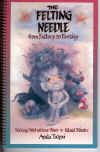
We now offer Ayala’s great needle felting book. It is easy to understand instructions that take you from start to finish in easy to learn steps. Included with the book are 4 felting needles. The book is $18.95 plus $3.50 postage. Needle felting can be done with any fiber. You can add decoration easily to garments with this technique. Easy and fun!!!
We have 3 fabulous Icelandic horses for sale. They are easy keepers, docile, sweet, friendly, smooth gaited and problem free. The ONLY reason they are for sale is that the sheep business takes all of my time and there is no time to ride!!!
We have a 4-year-old stallion, black/dun with a white star named Bjorn (bear). $3500.OBO
Also a chestnut mare with flaxy mane that is about 7 and bred to Bjorn for a fall foal. Kitla is green broke and easy to train and ride. $7000 OBO
Tickle is a 9-month-old filly, red/dun with blaze, sweet and beautiful. $3500 OBO
We will make a package deal on the above. Call if you are interested and we will talk.
In response to popular
demand Rex spent the winter working on some hand tooled silver barrettes, pins
and scarf slides. For photos of some of his work and prices see our website.
http://www.icelandicsheep.com/Silver.htm
With the purchase of $800 from our sales list the buyer can select a white AI ram from the FREE RAM list at no extra cost. Only one ram per family/farm/etc. Buyer pays shipping on the free ram if a shipper delivers. If we deliver then delivery is free.
10% discount on three or more sheep.
Big discounts on volume purchases/ the more you buy the more you save.
Free delivery to your area. We usually deliver in October.
1/3 down is required to hold your choice. The rest is due before the sheep leaves the farm or on delivery.
|
Home | Breeding Stock | Products | Contact Us |
|
|
photos, graphics, and text: © Copyright Tongue River Farm, 2000 |
since 1-21-02